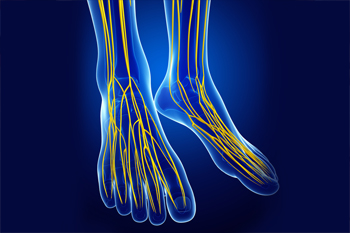Items filtered by date: September 2025
Uncovering Nerve Entrapment Syndromes in the Foot and Ankle

Nerve entrapment syndromes in the foot and ankle occur when surrounding tissues compress or irritate a nerve. This pressure can create pain, tingling, numbness, or even burning sensations that often mimic other conditions, making diagnosis more complex. Common areas where this happens include the tarsal tunnel along the inner ankle and the top of the foot where nerves can become trapped by wearing tight footwear or repetitive strain. Athletes and individuals who spend long hours on their feet are especially prone to these syndromes. Early detection is important because untreated nerve compression can lead to long term discomfort and muscle weakness. Identifying the underlying cause, whether it is footwear, injury, or repetitive stress, is the first step to relief. If you are experiencing persistent foot or ankle nerve symptoms, it is suggested that you schedule an appointment with a podiatrist for evaluation and appropriate care.
Foot Pain
Foot pain can be extremely painful and debilitating. If you have a foot pain, consult with Joseph Creswell, DPM from Practice. Our practitioner will assess your condition and provide you with quality foot and ankle treatment.
Causes
Foot pain is a very broad condition that could be caused by one or more ailments. The most common include:
- Bunions
- Hammertoes
- Plantar Fasciitis
- Bone Spurs
- Corns
- Tarsal Tunnel Syndrome
- Ingrown Toenails
- Arthritis (such as Gout, Rheumatoid, and Osteoarthritis)
- Flat Feet
- Injury (from stress fractures, broken toe, foot, ankle, Achilles tendon ruptures, and sprains)
- And more
Diagnosis
To figure out the cause of foot pain, podiatrists utilize several different methods. This can range from simple visual inspections and sensation tests to X-rays and MRI scans. Prior medical history, family medical history, and any recent physical traumatic events will all be taken into consideration for a proper diagnosis.
Treatment
Treatment depends upon the cause of the foot pain. Whether it is resting, staying off the foot, or having surgery; podiatrists have a number of treatment options available for foot pain.
If you have any questions, please feel free to contact our office located in Wallace, ID . We offer the newest diagnostic and treatment technologies for all your foot care needs.
What Are the Causes of Cracked Heels?
 The medical term for cracked heels can be referred to as heel fissures. They are defined as cracks in the outer edge of the heel that can be a result of dry skin. This can occur from wearing shoes that have an open back, or from standing on hard surfaces for the majority of the day. This condition can cause pain and discomfort, and in severe cases, bleeding may occur. There are many patients who find mild relief when the feet are soaked in warm water, followed by applying a good moisturizer. Additionally, a pumice stone may be used that can help to remove dead skin. Ignoring cracked heels can lead to fissures and increased risk of infection. For that reason, it is suggested that you consult a podiatrist who is able to offer safe treatment and suggest prevention techniques.
The medical term for cracked heels can be referred to as heel fissures. They are defined as cracks in the outer edge of the heel that can be a result of dry skin. This can occur from wearing shoes that have an open back, or from standing on hard surfaces for the majority of the day. This condition can cause pain and discomfort, and in severe cases, bleeding may occur. There are many patients who find mild relief when the feet are soaked in warm water, followed by applying a good moisturizer. Additionally, a pumice stone may be used that can help to remove dead skin. Ignoring cracked heels can lead to fissures and increased risk of infection. For that reason, it is suggested that you consult a podiatrist who is able to offer safe treatment and suggest prevention techniques.
Cracked heels are unsightly and can cause further damage to your shoes and feet. If you have any concerns, contact Joseph Creswell, DPM from Practice. Our practitioner can provide the care you need to keep you pain-free and on your feet.
Cracked Heels
Cracked heels appear unappealing and can make it harder for you walk around in sandals. Aside from looking unpleasant, cracked heels can also tear stockings, socks, and wear out your shoes. There are several methods to help restore a cracked heel and prevent further damage.
How Do You Get Them?
Dry skin is the number one culprit in creating cracked heels. Many athletes, walkers, joggers, and even swimmers suffer from cracked heels. Age and skin oil production play a role to getting cracked heels as well.
Promote Healing
Over the counter medicines can help, especially for those that need instant relief or who suffer from chronic dry feet.
Wear Socks – Wearing socks with medicated creams helps lock in moisture.
Moisturizers – Applying both day and night will help alleviate dryness which causes cracking.
Pumice Stones – These exfoliate and remove dead skin, which allows for smoother moisturizer application and better absorption into the skin.
Change in Diet
Eating healthy with a well-balanced diet will give the skin a fresh and radiant look. Your body responds to the kinds of food you ingest. Omega-3 fatty acids and zinc supplements can also revitalize skin tissue.
Most importantly, seek professional help if unsure how to proceed in treating cracked heels. A podiatrist will help you with any questions or information needed.
If you have any questions, please feel free to contact our office located in Wallace, ID . We offer the newest diagnostic and treatment technologies for all your foot care needs.
When Foot and Ankle Trauma Strikes

The foot and ankle are built to support the body’s weight, yet they are also vulnerable to injury. Ankle sprains are among the most common traumas, often caused by twisting the joint during sports or daily activity. These sprains can range from mild ligament stretching to more severe tears that limit stability. Fractures of the ankle and foot occur when bones break under stress or impact, while fracture dislocations combine broken bones with misaligned joints, creating serious complications. The lateral malleolus, the bone on the outer side of the ankle, is frequently fractured in sports injuries and may also be weakened by osteoporosis, making older adults more susceptible. Each type of trauma requires careful evaluation to avoid long-term problems with walking and balance. If you experience a foot or ankle injury, it is suggested that you see a podiatrist for appropriate treatment.
Foot and ankle trauma is common among athletes and the elderly. If you have concerns that you may have experienced trauma to the foot and ankle, consult with Joseph Creswell, DPM from Practice. Our practitioner will assess your condition and provide you with quality foot and ankle treatment.
Foot and ankle trauma cover a range of injuries all over the foot; common injuries include:
- Broken bones
- Muscle strains
- Injuries to the tendons and ligaments
- Stress fractures
Symptoms
Symptoms of foot and ankle injuries vary depending on the injury, but more common ones include:
- Bruising
- Inflammation/ Swelling
- Pain
Diagnosis
To properly diagnose the exact type of injury, podiatrists will conduct a number of different tests. Some of these include sensation and visual tests, X-rays, and MRIs. Medical and family histories will also be taken into account.
Treatment
Once the injury has been diagnosed, the podiatrist can than offer the best treatment options for you. In less severe cases, rest and keeping pressure off the foot may be all that’s necessary. Orthotics, such as a specially made shoes, or immobilization devices, like splints or casts, may be deemed necessary. Finally, if the injury is severe enough, surgery may be necessary.
If you have any questions, please feel free to contact our office located in Wallace, ID . We offer the newest diagnostic and treatment technologies for all your foot care needs.
Get Proper Treatment for Ankle Injuries
Essential Care for Diabetic Feet

Caring for diabetic feet is vital to prevent complications and maintain mobility. Pressure redistribution through supportive footwear and custom inserts helps reduce strain on sensitive areas. If a foot ulcer develops, proper cleaning and dressing are important steps, and antibiotics may be prescribed to prevent infection. Making regular podiatry appointments ensures early detection and treatment of issues before they become severe. A podiatrist can guide you in selecting the right shoes, provide wound care, and monitor circulation and nerve health to protect your feet long-term. If you are living with diabetes, it is strongly suggested that you are under the care of a podiatrist who can help you to manage this serious condition.
Diabetic foot care is important in preventing foot ailments such as ulcers. If you are suffering from diabetes or have any other concerns about your feet, contact Joseph Creswell, DPM from Practice. Our practitioner can provide the care you need to keep you pain-free and on your feet.
Diabetic Foot Care
Diabetes affects millions of people every year. The condition can damage blood vessels in many parts of the body, especially the feet. Because of this, taking care of your feet is essential if you have diabetes, and having a podiatrist help monitor your foot health is highly recommended.
The Importance of Caring for Your Feet
- Routinely inspect your feet for bruises or sores.
- Wear socks that fit your feet comfortably.
- Wear comfortable shoes that provide adequate support.
Patients with diabetes should have their doctor monitor their blood levels, as blood sugar levels play such a huge role in diabetic care. Monitoring these levels on a regular basis is highly advised.
It is always best to inform your healthcare professional of any concerns you may have regarding your feet, especially for diabetic patients. Early treatment and routine foot examinations are keys to maintaining proper health, especially because severe complications can arise if proper treatment is not applied.
If you have any questions, please feel free to contact our office located in Wallace, ID . We offer the newest diagnostic and treatment technologies for all your foot care needs.
Cracks in the Foot You May Not Be Aware Of

Metatarsal stress fractures are tiny breaks that develop in the long bones of the foot, usually from repetitive impact rather than a single injury. Unlike sudden fractures, these small cracks build over time, often starting as a mild ache that worsens with activity. Runners, dancers, and athletes who spend hours on their feet are especially vulnerable, but anyone who suddenly increases activity or wears shoes lacking adequate support can be at risk. Because the pain often begins subtly, many people mistake it for a bruise or simple soreness. Left untreated, stress fractures can progress into more serious injuries that take longer to heal. Rest, wearing protective footwear, and sometimes immobilization are key to recovery. Gradual return to activity under a podiatrist’s guidance helps ensure proper healing and prevents re-injury. If you have foot pain, it is suggested that you visit a podiatrist when it first starts for a diagnosis and appropriate treatment.
Stress fractures occur when there is a tiny crack within a bone. To learn more, contact Joseph Creswell, DPM from Practice. Our practitioner can provide the care you need to keep you pain free and on your feet.
How Are They Caused?
Stress fractures are the result of repetitive force being placed on the bone. Since the lower leg and feet often carry most of the body’s weight, stress fractures are likely to occur in these areas. If you rush into a new exercise, you are more likely to develop a stress fracture since you are starting too much, too soon. Pain resulting from stress fractures may go unnoticed at first, however it may start to worsen over time.
Risk Factors
- Gender – They are more commonly found in women compared to men.
- Foot Problems – People with unusual arches in their feet are more likely to develop stress fractures.
- Certain Sports – Dancers, gymnasts, tennis players, runners, and basketball players are more likely to develop stress fractures.
- Lack of Nutrients – A lack of vitamin D and calcium may weaken the bones and make you more prone to stress fractures
- Weak Bones – Osteoporosis can weaken the bones therefore resulting in stress fractures
Stress fractures do not always heal properly, so it is important that you seek help from a podiatrist if you suspect you may have one. Ignoring your stress fracture may cause it to worsen, and you may develop chronic pain as well as additional fractures.
If you have any questions please contact our office located in Wallace, ID . We offer the newest diagnostic and treatment technologies for all your foot and ankle needs.

